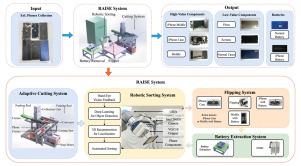RAISE: A Robot-Assisted SelectIve Disassembly and Sorting System for End-of-Life Phones
IF 10.9
1区 环境科学与生态学
Q1 ENGINEERING, ENVIRONMENTAL
引用次数: 0
Abstract
End-of-Life (EoL) phones significantly exacerbate global e-waste challenges due to their high production volumes and short lifecycles. Disassembly is among the most critical processes in EoL phone recycling. However, it relies heavily on human labor due to product variability. Consequently, the manual process is both labor-intensive and time-consuming. In this paper, we propose a low-cost, easily deployable automated and selective disassembly and sorting system for EoL phones, consisting of three subsystems: an adaptive cutting system, a vision-based robotic sorting system, and a battery removal system. The system can process over 120 phones per hour with an average disassembly success rate of 98.9%, efficiently delivering selected high-value components to downstream processing. It provides a reliable and scalable automated solution to the pressing challenge of EoL phone disassembly. Additionally, the automated system can enhance disassembly economics, converting a previously unprofitable process into one that yields a net profit per unit weight of EoL phones.

提高:机器人辅助选择性拆卸和分类系统的报废电话
报废(EoL)手机由于其高产量和短生命周期而显著加剧了全球电子垃圾挑战。拆卸是EoL手机回收中最关键的过程之一。然而,由于产品的可变性,它严重依赖于人力劳动。因此,手工过程既费力又耗时。在本文中,我们提出了一种低成本,易于部署的EoL手机自动和选择性拆卸和分拣系统,该系统由三个子系统组成:自适应切割系统,基于视觉的机器人分拣系统和电池拆卸系统。该系统每小时可处理120多部手机,平均拆卸成功率为98.9%,有效地将选定的高价值部件运送到下游加工。它为EoL电话拆卸的紧迫挑战提供了可靠和可扩展的自动化解决方案。此外,自动化系统可以提高拆卸经济性,将以前无利可图的过程转变为每单位重量的EoL手机产生净利润的过程。
本文章由计算机程序翻译,如有差异,请以英文原文为准。
求助全文
约1分钟内获得全文
求助全文
来源期刊

Resources Conservation and Recycling
环境科学-工程:环境
CiteScore
22.90
自引率
6.10%
发文量
625
审稿时长
23 days
期刊介绍:
The journal Resources, Conservation & Recycling welcomes contributions from research, which consider sustainable management and conservation of resources. The journal prioritizes understanding the transformation processes crucial for transitioning toward more sustainable production and consumption systems. It highlights technological, economic, institutional, and policy aspects related to specific resource management practices such as conservation, recycling, and resource substitution, as well as broader strategies like improving resource productivity and restructuring production and consumption patterns.
Contributions may address regional, national, or international scales and can range from individual resources or technologies to entire sectors or systems. Authors are encouraged to explore scientific and methodological issues alongside practical, environmental, and economic implications. However, manuscripts focusing solely on laboratory experiments without discussing their broader implications will not be considered for publication in the journal.
 求助内容:
求助内容: 应助结果提醒方式:
应助结果提醒方式:


